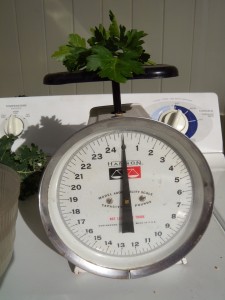Happy New Year to gardeners and gardens everywhere! I have two gardening resolutions for 2014. First: improved record keeping.
Keeping garden records
This year, I aim to faithfully record all of our planting and harvesting, as well as calculate the approximate monetary value of the harvest. The idea of keeping gardening records delights me (no, really, I’m weird like that). Unfortunately, despite my best intentions over the years, our garden records remain mediocre at best.
As I explained in a garden record keeping post almost two years ago, we (usually) keep track of our planting and harvesting using a binder method I developed after interning on a small organic farm/CSA. In theory, these records are quite detailed, including date sown, vegetable variety, quantity sown (and age of seeds), number of plants to emerge, the bed in which they are planted, transplant date, units harvested/pounds harvested, date of harvest, and a section for additional notes. Ha!
Many other food gardeners and small-scale farmers make a point of keeping careful records and tallying money saved. Their blogs inspire me toward better self-discipline, and I am grateful to them for reminding me that really good record keeping is not only ideal, but also possible. Thomahaak Family Farm keeps fabulous records of produce harvested (right down to herbs weighing fractions of a pound). I appreciate Dog Island Farm’s tally of both farm savings and expenditures. Starving off the Land has gone so far as calculating calories harvested, setting goals for the percentage of household caloric need met by first-hand food.
Recording small harvests
Aside from lack of consistency in actually writing things down, one of the most challenging aspects of garden record keeping for me is the fact that we often harvest very small quantities of veggies and herbs. If, as occurred yesterday morning, I wander outside in my pajamas to pick a few sprigs of parsley, a small bunch of cilantro, and about five leaves of kale to throw into a smoothie, how do I effectively and efficiently record this?
It was January 1st; my resolve was brand new, and I had nowhere to rush off to. Under Kelly’s skeptical eye, I got down the small kitchen scale and attempted to weigh the bounty. The parsley and cilantro each weighed in at approximately 1/32 lb. The kale was more like 1/16 lb. That’s if I trust my scale—an old, non-digital thrift store find.
Kelly pointed out that she doesn’t see how keeping these kinds of records actually benefit our gardening efforts. She also informed me that she was not prepared to follow my example. She suggested that employing a rougher estimate of our planting and consumption habits still allows us to adjust future planting accordingly, without going off our gourds trying to weigh every sprig of parsley.
I see her point.
Still, I am moved to redouble my record keeping efforts and to experiment with how to do this in a sustainable and useful manner.
Keeping records for smarter gardening
I would argue that good garden records make for smarter gardening. It’s easy to implement changes in the garden when you have the facts in front of you. We have adjusted the varieties of onions we grow based on our yearly yield. This is possible because we weigh the harvest every spring and compare varieties. If we tally money saved on produce grown at home, we can make smarter choices about how to prioritize space in our veggie gardening beds.
Record keeping can also serve as justification to ourselves for how we allocate our time and resources. I grow food for many reasons—not all of them rational. But record keeping can illustrate the good, solid, sensible reasons to grow food. It can provide us with data and supportive evidence for the difference our gardening efforts make in our diet and budget.
I can promise right now that this year’s records won’t be perfect, but I will experiment to improve our system and our consistency. In the first two days of the new year, I’ve started jotting records on our 2014 calendar. I think this method will be especially useful for tracking eggs—an almost daily harvest. I am also considering creating standardized measurements for certain common small harvests. For example, knowing the weight of the small bunches of cilantro, parsley, and kale I add to our smoothies, I may record these harvests as ‘small bunch cilantro,’ rather than weighing each bunch.
How do you keep your garden records? And why do you keep them (or not!)?



6 Responses to 2014 Garden Resolution #1: Improved Garden Record Keeping